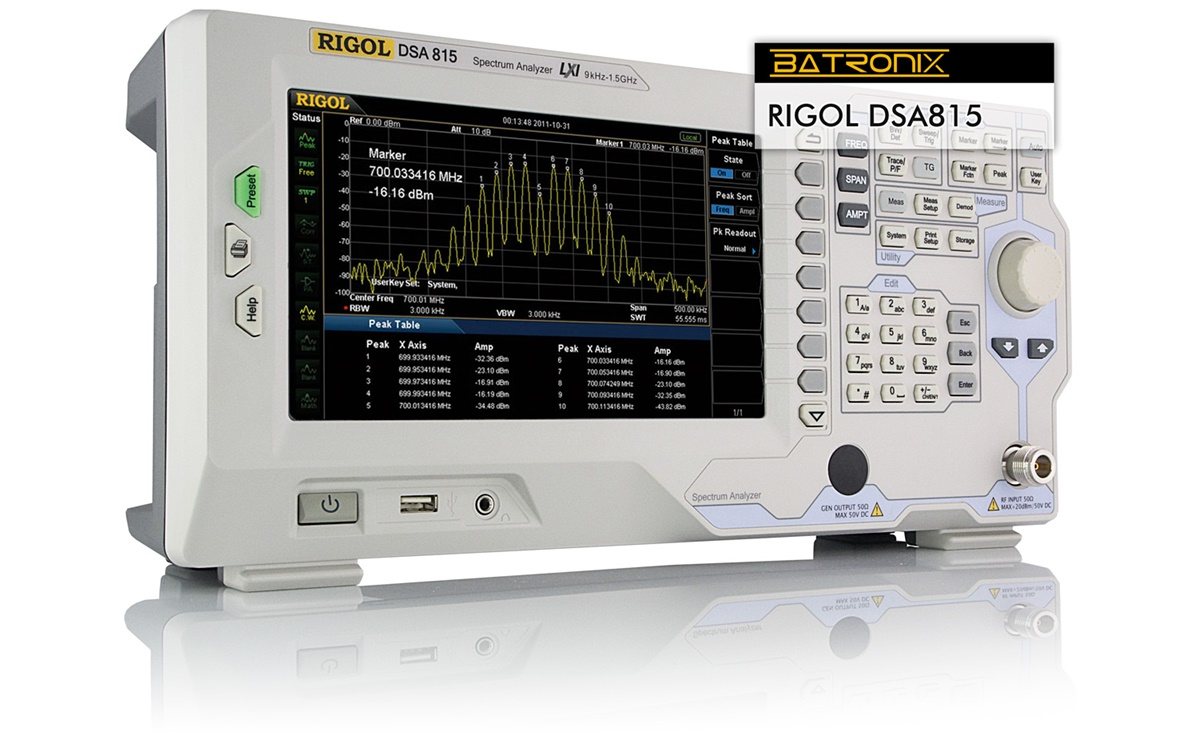

This generally requires using a certified testing lab and special equipment that can be cost prohibitive for development and design tweaking.

#Dsa815 conducted emissions full#
This note will briefly cover some common practices for conducted emission testing early in the design phase and we will cover the radiated emissions in another note.įor full qualification testing, a CISPR 16 qualified EMI Receiver and the proper setup must be used. Radiated emissions are those that are emitted into the area surrounding the EUT. Conducted emissions are those that propagate through the power line connecting the instrument (Equipment Under Test, or EUT here). In almost every case, these specifications contain limits on conducted and emitted radiation testing. This Electromagnetic Compatibility (EMC) testing is an integral part of product design and qualification for any electronics intended for sale within those markets. In an effort to minimise these issues, countries have established standards and limits to products that are being sold within that market. These effects can range from annoying glitches to rendering a product unusable. The Tektronix PA1000 power analyser allows doing mains input current harmonic measurments (up to 50th mains harmonic, ie 2500Hz).EMC Precompliance Testing: Conducted EmissionsĮlectromagnetic Interference (EMI) can cause undesirable effects on electronic products. I am a little concerned that it only has 1 Megaohm input impedance BNC connection ports.ĭoes a PA1000 Power analyser contain a LISN within itself?. Thanks, do you think the Picoscope 2205A can be conected to th LISN to do testing of conducted emissions? (L2 = 250uF and C2 = 4uF)Īlso, it says that the L2 inductors are coupled inductors (common mode choke)….but I thought the LISN was also supposed to be able to measure common mode emissions?Īlso, for measuring common mode emissions, I presume the kit has to be able to allow measurement of 100MHz plus? Common mode conducted emissions, as I understand it, are rarely prevalent below about 10MHz?Īlso, how do you make a LISN that can allow common mode emissions measurement? Do you have to use a coupling network out of coupled coils?Īlso, presumably there are problems when measuring common mode emissions because the signal level will be extremely low….so I presume some kind of broadband RF amplifier will be needed for its measurement?Īlso, if we dont make it in a metal box, (instead use plastic) then to what frequency will the LISN be effective up to? Does the input filter have to have these exact component values. The LISN diagram of the above link document (page 2) shows an input filter as well as the LISN.
#Dsa815 conducted emissions series#
However, if we just pick say an inductor with a SRF of about 7MHz, then does that mean that our readings of conducted emissions will be OK up to around 5MHz? Also, suppose we want an increased SRF, then can we just solder in series a load of say 3uH inductors till we get to the 50uH value (then the SRF will be higher)Īt the moment we have picked this inductor. The inductor should feature damping resistance along the coils to reduce ringing due to the inductors self resonant frequency. This inductor is supposed to be air core, made by hand winding over plastic drum. We wish to make our own cheap Conducted Emissions test kit for our 50-250W UK mains powered LED luminaires. I hope the HM6050 will have these things incorporated into it? Do you know how we ensure the low impedance to earth?Īlso, 4:07 onwards of this video shows that as well as a LISN, we will need a transient protector, a filter/selector, and a pre-amplifier leading up to the spectrum analyser. It also begs the question of what type of mud our factory is built on.because if the foundations have a high impedance to earth, then again, our conducted emc test results will be compromised, because a really low impedance to earth is needed for the conducted emc test. As you know, the metal sheet ground plane cannot simply be wired to an earth point in a mains plug. I presume we would have to connect it near the main earth wire input connection to our building.after all, if the metal ground plane on which the emc test is carried out doesnt have a really low impedance to earth, then this will compromise the results.

We also wonder where we would put the metal sheet ground plane to ensure it is a low impedance to earth. Then again, we only want to go up to 30MHz so i am kind of wondering why it has to be bolted for that, i mean, 30MHz is hardly microwave frequency. As you know, simple wire connection to the ground plane is unacceptable for conducted emc testing, because it would be too high impednace at the higher frequencies. Thanks, the Hameg HM6050 looks good but doesnt say if it has facility to be bolted to a ground plane.


 0 kommentar(er)
0 kommentar(er)
